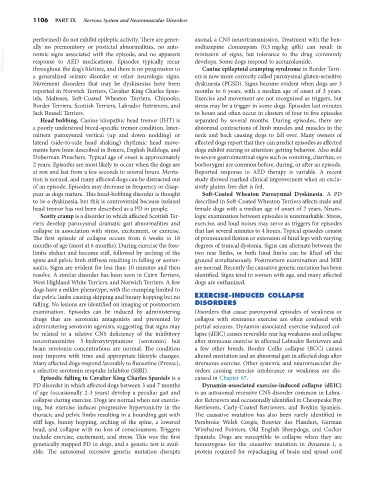Page 1134 - Small Animal Internal Medicine, 6th Edition
P. 1134
1106 PART IX Nervous System and Neuromuscular Disorders
performed) do not exhibit epileptic activity. There are gener- axonal, a CNS neurotransmission. Treatment with the ben-
ally no premonitory or postictal abnormalities, no auto- zodiazepine clonazepam (0.5 mg/kg q8h) can result in
VetBooks.ir nomic signs associated with the episode, and no apparent remission of signs, but tolerance to the drug commonly
develops. Some dogs respond to acetazolamide.
response to AED medications. Episodes typically recur
Canine epileptoid cramping syndrome in Border Terri-
throughout the dog’s lifetime, and there is no progression to
a generalized seizure disorder or other neurologic signs. ers is now more correctly called paroxysmal gluten-sensitive
Movement disorders that may be dyskinesias have been dyskinesia (PGSD). Signs become evident when dogs are 3
reported in Norwich Terriers, Cavalier King Charles Span- months to 6 years, with a median age of onset of 3 years.
iels, Malteses, Soft-Coated Wheaten Terriers, Chinooks, Exercise and movement are not recognized as triggers, but
Border Terriers, Scottish Terriers, Labrador Retrievers, and stress may be a trigger in some dogs. Episodes last minutes
Jack Russell Terriers. to hours and often occur in clusters of four to five episodes
Head bobbing. Canine idiopathic head tremor (IHT) is separated by several months. During episodes, there are
a poorly understood breed-specific tremor condition. Inter- abnormal contractions of limb muscles and muscles in the
mittent paroxysmal vertical (up and down nodding) or neck and back causing dogs to fall over. Many owners of
lateral (side-to-side head shaking) rhythmic head move- affected dogs report that they can predict episodes as affected
ments have been described in Boxers, English Bulldogs, and dogs exhibit staring or attention-getting behavior. Also mild
Doberman Pinschers. Typical age of onset is approximately to severe gastrointestinal signs such as vomiting, diarrhea, or
2 years. Episodes are most likely to occur when the dogs are borborygmi are common before, during, or after an episode.
at rest and last from a few seconds to several hours. Menta- Reported response to AED therapy is variable. A recent
tion is normal, and many affected dogs can be distracted out study showed marked clinical improvement when an exclu-
of an episode. Episodes may decrease in frequency or disap- sively gluten-free diet is fed.
pear as dogs mature. This head-bobbing disorder is thought Soft-Coated Wheaton Paroxysmal Dyskinesia. A PD
to be a dyskinesia, but this is controversial because isolated described in Soft-Coated Wheaton Terriers affects male and
head tremor has not been described as a PD in people. female dogs with a median age of onset of 2 years. Neuro-
Scotty cramp is a disorder in which affected Scottish Ter- logic examination between episodes is unremarkable. Stress,
riers develop paroxysmal dramatic gait abnormalities and exercise, and loud noises may serve as triggers for episodes
collapse in association with stress, excitement, or exercise. that last several minutes to 4 hours. Typical episodes consist
The first episode of collapse occurs from 6 weeks to 18 of pronounced flexion or extension of hind legs with varying
months of age (most at 6 months). During exercise the fore- degrees of truncal dystonia. Signs can alternate between the
limbs abduct and become stiff, followed by arching of the two rear limbs, or both hind limbs can be lifted off the
spine and pelvic limb stiffness resulting in falling or somer- ground simultaneously. Postmortem examination and MRI
saults. Signs are evident for less than 10 minutes and then are normal. Recently the causative genetic mutation has been
resolve. A similar disorder has been seen in Cairn Terriers, identified. Signs tend to worsen with age, and many affected
West Highland White Terriers, and Norwich Terriers. A few dogs are euthanized.
dogs have a milder phenotype, with the cramping limited to
the pelvic limbs causing skipping and bunny hopping but no EXERCISE-INDUCED COLLAPSE
falling. No lesions are identified on imaging or postmortem DISORDERS
examination. Episodes can be induced by administering Disorders that cause paroxysmal episodes of weakness or
drugs that are serotonin antagonists and prevented by collapse with strenuous exercise are often confused with
administering serotonin agonists, suggesting that signs may partial seizures. Dynamin-associated exercise-induced col-
be related to a relative CNS deficiency of the inhibitory lapse (dEIC) causes reversible rear leg weakness and collapse
neurotransmitter 5-hydroxytryptamine (serotonin) but after strenuous exercise in affected Labrador Retrievers and
brain serotonin concentrations are normal. The condition a few other breeds. Border Collie collapse (BCC) causes
may improve with time and appropriate lifestyle changes. altered mentation and an abnormal gait in affected dogs after
Many affected dogs respond favorably to fluoxetine (Prozac), strenuous exercise. Other systemic and neuromuscular dis-
a selective serotonin reuptake inhibitor (SSRI). orders causing exercise intolerance or weakness are dis-
Episodic falling in Cavalier King Charles Spaniels is a cussed in Chapter 67.
PD disorder in which affected dogs between 3 and 7 months Dynamin-associated exercise-induced collapse (dEIC)
of age (occasionally 2-3 years) develop a peculiar gait and is an autosomal recessive CNS disorder common in Labra-
collapse during exercise. Dogs are normal when not exercis- dor Retrievers and occasionally identified in Chesapeake Bay
ing, but exercise induces progressive hypertonicity in the Retrievers, Curly-Coated Retrievers, and Boykin Spaniels.
thoracic and pelvic limbs resulting in a bounding gait with The causative mutation has also been rarely identified in
stiff legs, bunny hopping, arching of the spine, a lowered Pembroke Welsh Corgis, Bouvier des Flanders, German
head, and collapse with no loss of consciousness. Triggers Wirehaired Pointers, Old English Sheepdogs, and Cocker
include exercise, excitement, and stress. This was the first Spaniels. Dogs are susceptible to collapse when they are
genetically mapped PD in dogs, and a genetic test is avail- homozygous for the causative mutation in dynamin-1, a
able. The autosomal recessive genetic mutation disrupts protein required for repackaging of brain and spinal cord

